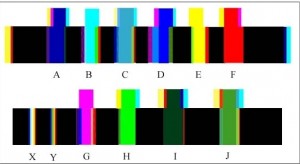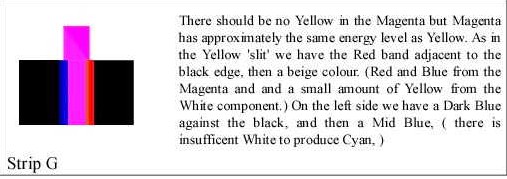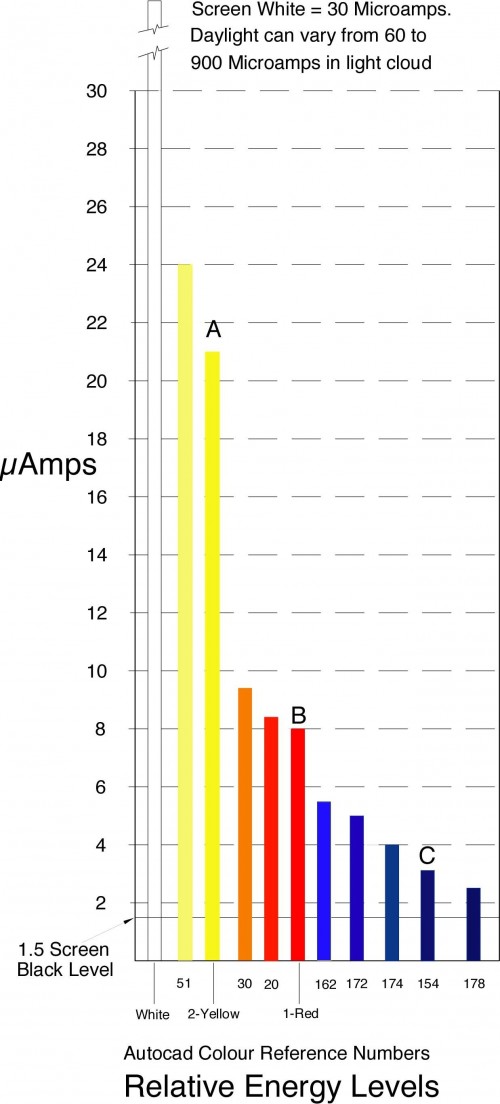-
Plea to Programmers and Instruction Manual Writers.
Posted on October 27th, 2010 No commentsInstructions: Open packet, Eat nuts.
On an American Airlines packet of nuts.
Rather silly, because everybody knows this. However, the main problem with the above is not that it is silly but that the writer has missed the most important part of the instructions, which is “How to open the packet”.
How many times have you seen crisps or peanuts flying in all directions, due to people struggling to open a packet.
I would imagine that a good proportion of the time spent by clean-up crews, is finding and removing peanuts and crisps from inaccessible places on the aircraft. This means that many $1,000s are wasted each year, and probably a few tons of peanuts and crisps are wasted.
All because of incompetent instructions.
The same type of silliness is endemic in the computer industry. From the classic Microsoft silliness of having to press the ‘Start’ button to ‘Stop’ the the computer, to far more serious lapses of intelligence that costs $millions every year.
Too many ‘technical writers’ assume that the reader knows as much about the subject as they do. Obviously this is silly, because if they did they wouldn’t need to read the instructions. As an engineer I have spent a lot of time over the years writing instructing manuals for all types of equipment.
Very early on in my career I determined that any instructions that I wrote should be understandable by my grandmother. (Not literally as both my grandmothers died before I started work.)
Tips on writing instructions.
- Know what you are writing about.
- Assume that your reader does not know anything about handling or using the equipment or system.
- Do not use abbreviations for anything unless there is clear information on the same page to explain the meaning.
- Avoid using obscure (to the public) technical terms, it may seem clever to you but it brands you as a lousy technical writer.
- Try and stay with a common vocabulary. Almost anything can be explained by using less than 500 commonly known words in any language.
- None of the above mean that you have to treat the readers as idiots. That fact that you can’t understand your wife’s knitting pattern does not mean that you are an idiot. Give the same consideration to your readers.
Most computer related instruction manuals contain parts that are mostly ‘gobbledegook’ ( a word or series of words that are meaningless) to the reader . Get your grand mother to check all your work for gobbledegook, because you won’t be able to recognize it yourself. Someone at the next desk to you may understand what you are trying to say, but real people won’t.
As a good guide to technical writing you should read the computer technical guides by David Welsh Pogue. A master at his subjects and a super sense of humour. No, he is not paying me for saying that, I just think he is the best technical writer on computers I have read, and it is pertinent to this posting. Just borrow one from the library to read irrespective of your particular computer preference.
********************************************************************
Many years ago I was urgently requested to handle the technical information department of a wire and cable making machinery company. The first few weeks were very hectic because they were months behind in their delivery of instruction manuals, and I was unfamiliar with the machinery. After about 6 weeks I started to get involved with the engineering departments to get familiar with the equipment, and to study the “standard” sections of the manuals that I had been sending out. I found that I could not reconcile the information in these “Standard” sections with what I had learned in the engineering and manufacturing departments.
I then had a meeting with the companies commissioning engineers to discuss my problems. I found that they could not make sense of the “standard” documentation either. Checking up later I found that some of these inaccurate “standard” documents had been issued over a period of 10 years without anyone, even clients, complaining about them.
Over the next few weeks I had to rewrite all the standard sections, and create graphics where I thought necessary.
It is clear therefore, that because no-one had complained over a period of 10 years, nothing had been done about the problem. $1000s must have been wasted over this 10 year period due to people having to work out for themselves how to operate equipment. Another problem here is that if people cannot understand a particular set of instructions, they tend to consider that it is their fault for being stupid. In almost all cases it means that the writer of the instructions was incompetent.
How many times have you read the following or similar, in computer operating manuals, ” It is better if you spend a little time playing about with your computer”. Generally this means that the writer himself is totally confused and would rather you worked it out for yourself.
********************************************************************
A further problem I discovered was with translations. Translating technical subjects is full of pitfalls for the unwary. Is it a bolt or a set-screw? Is it a cog or a sprocket? Having the correct definition makes it more likely that the translation will be correct. Sometimes it may be necessary to supply photographs or diagrams with the English text to enable the translator to supply the correct words.
In many cases I found it necessary to produce separate “Translatable English ” versions of operating instructions.
—————————————————
From the WordPress Help Pages.
“If none of this make sense and you have someone to administrate your system for you, show the above to them and they should be able to figure it out.”
Maybe!!!!!!!!!! And what if I don’t?
WordPress writers do have an excuse, because they write these from the goodness of their hearts, and most of them have other jobs to do.
——————————————–
If you find words in my web site that do not appear to be be sensible in none-English languages, please send information and I will try to re-word it.
Author – Brian Williams
-
Colour Test Bars – 2 of 2
Posted on October 16th, 2010 No commentsThe use of these test bars gives us a method of accurately determining ‘True’ colours and also giving an accurate specification for any colour. At present there are no reliable standards for colours. You can compare colour charts from all sources without getting a match for a stated colour. It also gives us a more reliable method of measuring colour blindness.
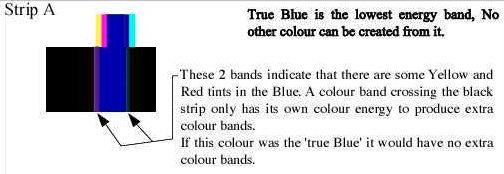
Blue Slit
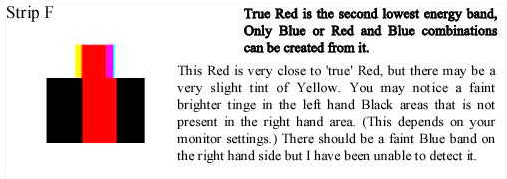
Red Slit

Yellow Slit
Obviously my method of using the computer monitor as the colour source only gives approximations. As a pensioner I am unable to spend £millions on buying equipment. My total outlay on scientific equipment for this series of experiments was under £5.00.
The extra energy added to the colours due to the radiated Black screen energy of 1.5 micro amps made a serious distortion in the colours, particularly the Blues.
Author – Brian Williams
-
Boil or Carbuncle?
Posted on October 14th, 2010 No commentsIS IT A BOIL OR IS IT A CARBUNCLE?
Summary of differences. Boil,- Painful and throbbing from first day.
- A head will be evident at the infection site on a boil.
- Bursting the head on a boil will relieve the pain.
- Bursting the Head will release pus from the centre of the boil
- The pus leakage will be followed by blood leakage.
- After bleeding stops, healing starts.
- Penicillin, antibiotics will rapidly cure the problem if needed.
- Boils may have multiple heads.
- No throbbing or pain.
- No head visible for a few days or even weeks.
- Swelling in the general area.
- Tapping on the head of the carbuncle when it forms gives a burning sensation.
- When carbuncle bursts, pus leaks out around a central jelly-like core.
- Leakage of pus and blood may continue for weeks or months.
- Penicillin/antibiotics have no curative affect.
- I have never had a multi-headed carbuncle.
- The pus from a carbuncle has a distinctive smell (Stink).
Finally my mother told me to go our local chemist who had a very good reputation. After telling him the whole sad story, he said that he needed to check exactly what is was and then removed the bandages. On revealing the ‘boil’ he immediately said that it was not a boil, but a carbuncle.
He also said that it was easily treated!
He then went around to the back of the shop and returned a few minutes later with a small bottle containing lots of small grey pills.
It cost me 2 shillings (10 new pence). That included supplying his own bottle, the label, his time spent on examinations and profit.
He told me to take all the tablets according to the instructions, and to return when the swelling had gone down.The following morning the swelling had reduced considerably, and by the third day all the swelling had gone, just leaving the original ‘boil’.
Re-examination by the chemist revealed a 1″ diameter open wound with 3/4″ diameter yellow core of Jelly like consistency, which he immediately dug out with some difficulty.
By the end of the week the only sign of the carbuncle was a small scar, which I still have.
What did I learn from our local chemist about carbuncles?
Most of the knowledge about carbuncles came from experiences in the two world wars. He did say that the ‘Multi-headed boil’ description was false and that carbuncles could be single or multi-headed. (I managed to work out why later.)
I have had many carbuncles over the years. One possible reason is that I am susceptible to them. The main reason is that in the early days I got them by being in the wrong place, which is old attics. During the First World War many British soldiers were fighting in old houses and other buildings, many of which were severely damaged. They were covered in the dust from attics and roofs. and quickly infected with boils and/or carbuncles. In the Second World War people in bomb damaged areas were infected with boils and/or carbuncles.
Before this carbuncles were not unknown, but were considered to be just another type of boil, the main difference being that in many cases the carbuncles proved to be fatal.
The first five times I got them after doing work in old attics. but these were rapidly cured without much bother by stannous oxide tablets. Since then I have been unable to obtain the necessary remedy and so have had to go through months of aggravation, changing dressings 2/3 times a day. My last one (about 8 years ago) lasted 16 months and cost me £100’s in dressings plus £100’s in subsidised antibiotics plus continual supplies of vitamin supplements.
Update 30th October 2011. My latest one, started late September 2010 (under my right arm) has now been with me for 13 months. This is probably the one that will kill me, due to my age.
Up date March 11th 2015. The one under my right arm is still with me (3 years and 5 months) One in my groin area has reactivated. At my last of 3 visits to ‘experts’ at local hospital 5-6 months ago, I was told that “….it doesn’t matter what you call it , you can only have antibiotics”. This from the senior consultant.
How to Identify a Carbuncle.
Simplest and quickest test is just to tap on it with your finger. If there is a sharp pain it is probably a boil. If it gives a burning sensation, similar to that caused by holding a cigarette end close to the skin, it is almost certainly a carbuncle.
Carbuncle: [L. carbunculus, dim. of carbo, a live coal, a carbuncle]
Source: Stedman’s Medical Spellchecker, © 2006 Lippincott Williams & Wilkins. All rights reserved.
You would think that this would give a clue to the medical profession!!!
A boil is nearly always more painful than a carbuncle. This is one of the reasons for the ‘multi-headed boil’ problem. You can have a carbuncle for many days without realising it, but a boil makes its present felt immediately. A carbuncle can reach the bursting stage before you become aware of it. When a carbuncle bursts the infection gets smeared across the skin which then creates more ‘heads’. The human body creates a protective film around the site of a boil or carbuncle to prevent the infection spreading and to confine the ‘safety valve’ nature of it to one location. If any of the infected pus from a carbuncle is smeared outside this protected area, new carbuncles start. Contact with this pus can start infections in healthy people, as happened once with my wife. (Luckily for me, the cure was still available at this time.)
If the first infection head is properly ‘dressed’, further heads are prevented. Note; I was advised to do this by the chemist. I personally have never had a multi-headed carbuncle. I have had multi-headed boils.
A second identifier is that boils ‘throb’, carbuncles don’t, another reason why they get ignored.
A third identifier for carbuncles is the ‘core’, the yellow hard jelly like centre. In boils the yellow centre remains liquid and normally comes out first on bursting. In carbuncles the yellow centre remains until you physically extract it.
Treatment
The only effective treatment is no longer available in Britain. I have had a prescription for 8 years that I have been unable to have made up despite trying many pharmacists, medical supply companies and even one of the companies that used to manufacture them. (They did not even have a record of ever having made them, even though I have an old empty bottle of theirs.)
The original treatment was a compound of tin and tin oxide in tablet form.
Each tablet contains the following:-
- Tin Powder – 0.10625grammes
- Stannous Oxide – 0.01875 grammes
-
Day 1 – 16 tablets (4 + 4 + 4 + 4 )
-
Day 2 – 14 Tablets (4 + 4 + 3 + 3 )
-
Day 3 – 12 Tablets. (3 + 3 + 3 + 3 )
-
Day 4 – 10 Tablets. (3+ 3 +2 + 2 )
-
Day 5 – 8 Tablets. (2 + 2 + 2 + 2 )
-
Day 6 – 6 Tablets. (2 + 2 + 1 + 1 )
-
Days 7 /8/9 and 10 as Day 6
The bracketed numbers indicate the number of tablets to be taken at intervals over the day. It is always best to space them at 6 hour intervals, but it is not crucial.
Why the Cure has been missed by the medical profession.
- Manufactures started marking the the tablets “For use against boils and carbuncles”, but they were totally ineffective against boils. So much for the manufacturers ‘expertise’. Even today they still use the term “for Boils and Carbuncles” on commercial products. Tin and its oxide do not work on boils, antibiotics do not work on carbuncles.
- Doctors were using them for boils, found they did not work, therefore stopped prescribing them. Doctors did not know the differences between boils and carbuncles. It is possible that some doctor had diagnosed a carbuncle as a boil (because it only had a single head) and prescribed stannous oxide, found that it worked, and advised other doctors of this. Later it became obvious that it did not work on real boils and was discontinued.
Having spent many hours over the years discussing carbuncles with members of the medical profession, including dermatologists, I have still not met one who knew the difference. Nor have I met one who had ever had a carbuncle. - Doctors, like many people, generally only learn what they are taught, and what little I have found about carbuncles in medical publications has been very sketchy. Case studies are almost non-existent ( Who wants to read a case study on carbuncles? Therefore why should I do one?) To be honest I’ve not managed to find one yet.
General.
The use of metallic oxides in medicine has received a lot of attention in recent years, particularly in regard to viral infections.
The fact that streptococcus (the claimed cause of boils and carbuncles) is unaffected by tin oxides, clearly indicates that carbuncles are not caused by streptococcus. (This from my experience that anti-streptococcus injections and pills had no effect on carbuncles.) Note that they may have been helpful in that they cleared a lot of streptococcus from the system.
There is a bit of confusion here. When the body is attacked by ‘nasties’, its immune system goes into overdrive. The white blood cells move into action attempting to destroy every kind of ‘nasty’ they can find. The white blood cells will, if possible, kill everything they recognize as a ‘nasty’. Streptococcus is something they recognize and can usually destroy. If you are infected with anything, streptococcus will be found, if only by collateral damage, (they may not be what is causing the problem but will be killed anyway.)
The white blood cells may not even recognize what is actually causing the infection, and therefore ignore it. It is possible that carbuncles are caused by viruses. It may be that streptococcus are carriers of viruses.
It is also possible that the virus responsible for Legionaire’s Disease is the same virus, or similar, to that causing carbuncles. The similarities in origin, attic dust and ventilation dust, would indicate that some further investigation is needed. It would also give the possibility of stannous oxide as a cure for Legionaire’s Disease. Modern ducting systems, using inert materials like plastics or stainless steel, do not have the advantage of having a inner coating of metal oxides (Zinc Oxide) that the traditional galvanised steel has.
It would be nice if Stannous Oxide was available again. because I’ve always had the feeling that carbuncles would eventually kill me.
The only side effect I ever had was that I had to do household tasks sooner.
—————————
Medical Importance of Tin.
TIN by trapper/kcmo .....
Date: 4/29/2011
Hits: 2042
URL:
Tin – Health Effects
Acu-Cell Analysis Acu-Cell Nutrition Acu-Cell Disorders Tin – Health Effects Mineral Ratios
The Clinical Research Resource for Cellular Nutrition using Acu-Cell Technology ™Health Benefits & Toxicity of the Element Tin, and its Effect on Adrenals, Depression and Fatigue
While Tin (Sn) has been established to be an essential trace element for some animals (they won’t grow well without it), some researchers are still unsure of whether tin is essential to human health. Daily dietary intake of tin from various food sources is in the 1 – 3 mg range, which is less than 1/10th of the daily intake obtained years ago before lacquering tin cans, switching to aluminum cans, or, in the more distant past, when tin cups or tin pans were still in use. Since bronze contains copper and tin, the use of tin has been established well past the Bronze Age, several thousand years ago.Rat studies have shown that tin-deficient diets resulted in poor growth, reduced feeding efficiency, hearing loss, and bilateral (male pattern) hair loss. Tipton and Shafer examined tin in human tissue after accidental deaths.
They noted that tin was found in the aorta, brain, heart, kidney, liver, muscle, ovary, spleen, pancreas, testes, stomach, and uterus, but none was found in the thyroid of any victim, while the prostate, which usually shows no other trace element, had tin.
(Is this lack of tin the cause of erectile dis-function and prostate cancer? Brian.
Average concentrations were the same range as cobalt, iodine, chromium, and selenium, which are known vital nutrients. Inorganic tin is capable of entering into biological activity at saline pH, and it is far less toxic than other known vital trace elements such as copper and cobalt. In addition, tin levels do not vary statistically with age, gender, or geographical areas. Misk found traces of tin in the fetal heart and spleen, and higher levels in the liver, while Schroeder and others reported no tin in stillborns.
As mentioned on the Acu-Cell “Tin & Iodine” page – where additional information about tin is found – Tin is associated with iodine in the same way as calcium is associated with magnesium. Tin supports the adrenals, and iodine supports the thyroid, with both subsequently affecting cardiac output: Tin + adrenals control the left side, and iodine + thyroid control the right side. In addition to low Vitamin C and/or Vitamin B1, low tin is a common nutritional cause of low adrenals, which can lead to left-sided cardiac insufficiency. While fatigue or depression may be experienced with cardiac insufficiency of either side, breathing difficulties or asthma are more common with left-sided cardiac insufficiency, and swelling of hands and is more common with right sided cardiac insufficiency, regardless of the cause.
Comparing thousands of patient records since the mid 70’s showed that better than 90% exhibited below normal levels of tin when referenced to the status of all other essential trace minerals, making it the most deficient element compared to any other trace mineral measured. Symptoms associated with low levels of tin typically include depression and/or fatigue, and others.
I had 285 individuals taking part in evaluating tin, some on a short-term basis (about 3 weeks), and others on a long-term basis (1 – 2+ years), resulting in some valuable feedback on various responses encountered, including side effects, although the poor absorption of stannous oxide was a limiting factor in being able to achieve optimal increases of cellular tin in all subjects.
Of those who experienced changes after supplementing tin, negative reactions, e.g. stomach / digestive upsets, or skin reactions were at par, or less compared to the best tolerated trace minerals such as calcium, chromium, or magnesium.
Positive health effects were numerous and included improvements with fatigue, and some forms of depression, with a general increase in energy, well-being and mood. There were also benefits with certain types of headaches, insomnia, asthma, or improvements with digestion, skin, or various aches and pains.
Tin toxicity documented over the last 200 years in humans has been associated with the consumption of foods or beverages that were stored in tinned, un-lacquered containers under long-term, low-pH conditions, and where levels of several hundred to several thousand mg / kg were ingested. Symptoms were limited to mostly gastrointestinal complaints such as nausea, abdominal pain and vomiting, with excess tin being rapidly excreted, and no long-term negative health or toxic effects reported.
There are many causes of depression, some resulting from abnormal brain chemistry, while others are associated with low blood pressure, low thyroid, or low (or high) levels of various essential nutrients such as lithium, calcium, magnesium, copper, sodium, protein, Vitamin B1, Vitamin B6, Vitamin B12, manganese (low blood sugar), among others. Many of these nutrients are well documented in affecting mood, but I have not previously come across any reference to tin until starting to do research on it, and after it helped some patients with depression where any other drug, nutrient, or intervention had failed.Tin is not a panacea for depression — it will not work when other chemical imbalances are involved, but it can be the missing link when most other attempts to resolve depression have failed; essentially involving low, or malfunctioning adrenals. For the same reason, some cases of asthma – particularly when related to low adrenals and subsequent left-sided cardiac insufficiency – respond to tin as well.
Tin (as stannous fluoride) is found in some toothpastes, and it has been used in the form of stannous chloride as a chemical preservative. It is also added to asparagus to improve its taste, while in some countries it has been utilized as a remedy for intestinal parasites.
Some herbal sources of tin (in the highest to lowest order) are doggrass, juniper, bilberry, milk thistle, dulse, lady slipper, althea, valerian, Irish moss, nettle, barberry, yarrow, blessed thistle, red clover, yellow dock, kelp, licorice, devils claw, pennyroyal, and senna. ¤General recommendations for nutritional supplementation: To avoid stomach problems and promote better tolerance, supplements should always be taken earlier, or in the middle of a larger meal. When taken on an empty stomach or after a meal, there is a greater risk of some tablets causing irritation, or eventually erosion of the esophageal sphincter, resulting in Gastroesophageal Reflux Disease (GERD). It is also advisable not to lie down immediately after taking any pills. When taking a very large daily amount of a single nutrient, it is better to split it up into smaller doses to not interfere with the absorption of other nutrients in food, or nutrients supplemented at lower amounts.
___________________
Copyright © 2011 Acu-Cell – Element Tin: Health Benefits & ToxicityDietary Reference Intake (DRI) is the latest term replacing daily dietary reference values such as:
Adequate Intake (AI *), Nutrient Reference Value (NRV), Tolerable Upper Intake Level (UL), Estimated
Average Requirements (EAR), and Recommended Dietary Allowance / Intake (RDA / RDI).Tin – (Stannous Oxide):
DRI (RDA): none
18 years + (suggested minimum) 10-20mg
Therapeutic Range: 25mg – 250mg
Estimated daily intake of tin from food and water (excluding canned food) is 1mg – 3mg per day.
Cellular / Intracellular Attributes, Functions and Interactions:
Tin Synergists:
Nickel, iodine, Vitamin B1, Vitamin C,Tin Antagonists:
Iron, calcium, copper, chloride,
Vitamin B2, Vitamin E, [bismuth, zinc].Low Levels / Deficiency – Symptoms and/or Risk Factors:
Fatigue, depression, low cardiac output (left side), low adrenals, shortness of breath, asthma, headaches, insomnia.
In Animals: Low tin results in poor growth, alopecia / bilateral hair loss, hearing loss, and reduced feeding efficiency.
High levels / Overdose / Toxicity / Negative Side Effects – Symptoms and/or Risk Factors:
Skin rash, stomach complaints, nausea, vomiting, diarrhea, abdominal pain, headache, palpitations.
Tin Sources:
Tinned / canned foods, cereal grains, dairy, meat, vegetables, seaweed, licorice, some toothpastes. ¤——————————————–
Extract from BBC news item. 1 October 2011
Copper fixtures could help hospitals combat infections such as MRSA, scientists say, because of its anti-bacterial and anti-viral properties.
In Trafford General Hospital, copper door handles and work surfaces are replacing stainless steel in the fight against the superbug.
Combined with meticulous hygiene, the new fittings have contributed to the hospital’s MRSA-free status for the past two years.
Copper oxide, zinc oxide, stannous oxide. For over 100 years Metal oxides have been known for their medical properties. When I was a child we knew that it was safe to suck copper coins. Zinc oxides were used in dressings and ointments and tin oxide was used for carbuncles. Why has the medical profession been so slow?
SEE ALSO;
Tin, BPA, BPS and Phthalates. Brian Williams
Author
-
Colour Test Bars
Posted on October 13th, 2010 No commentsThe drawing below is one I originally produced some 15 years ago as a cross-check on my theory that the spectrum colours originate from edges. It turned out to give quite a large quantity of information that confirms my theory.
Viewing different areas of the above through a prism gives you the various spectra shown below. I have tried 60°, 45° and 30° prisms and find that a 45° prism gives the best overall results. It is also the most readily available, from old cameras and binoculars.
At first the spectra below don’t seem to make much sense. However, if you bear in mind my previous pages it all starts to make sense. Note that I cannot guarantee the colour accuracy on your monitor or printer, I have had difficulties producing the colours actually seen, and some of the colours are definitely “off colour”. In practice you will probably see some faint strips that I consider to indicate that there is another colour in the pigment or being projected.
Note: The viewing distance between the screen and the prism affects the width of the bands.
It should be remembered that we are dealing with energy levels. A black screen radiates approximately 4.5% of the energy of a White screen, so that this may partly explain the less prominent colour bands, as it is produced from Cyan/Blue, Magenta/Red and Yellow/Green phosphors.
The next 3 sketches explain the colour bands on silhouettes of Blue, Red and Yellow.
It should be noted that a higher energy colour will encroach into part of the space occupied by a lower energy colour.
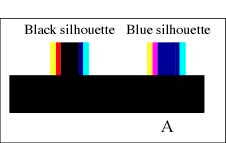 With a black silhouette, (Black being an absence of any colour energy) the Blue light dissipates readily into this area, which sometimes makes it difficult to see. Some Red may also encroach into this area.
With a black silhouette, (Black being an absence of any colour energy) the Blue light dissipates readily into this area, which sometimes makes it difficult to see. Some Red may also encroach into this area.In the Blue silhouette the Blue band becomes part of the silhouette that is radiating the same energy level. The energy gradient from White to Blue is less than the energy gradient from White to Black therefore there is no separate Blue band. The Red band encroaches on the Blue area creating a turbulence we perceive as Magenta.
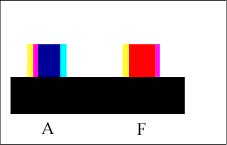 With the Red silhouette the energy gradient is less therefore we lose the Red band.
With the Red silhouette the energy gradient is less therefore we lose the Red band.The Cyan band merges into the Red area creating a turbulent mixture we see as Magenta. The Red band is part of the Red silhouette, which leaves us with a Yellow band.
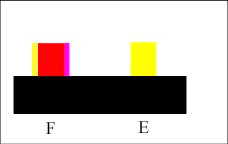 With the Yellow silhouette the energy gradient is only one step, i.e. White to Yellow; therefore there are no intermediate colour bands.
With the Yellow silhouette the energy gradient is only one step, i.e. White to Yellow; therefore there are no intermediate colour bands.Magenta and Cyan.
Now let us consider the ‘oddball’ colours, Magenta and Cyan. Both of these, as silhouettes, give a clean strip without any side bands when viewed through the prism. (Note: There are some very narrow bands but I consider that these are caused by carry-over from the screen phosphors.)
This is due to the high turbulence between White and the Blue in both Magenta and Cyan. The eye/brain cannot accurately determine the ratios of colours due to the fluctuating energies, but is aware of which section of the cones the signals are coming from, and the brain decides that fluctuating energy in the Blue area of the cones plus White light gives us Cyan, and that fluctuating energy in the Blue and Red areas of the cones plus White light gives us Magenta.
Without the high proportion of the White light, the brain can handle the fluctuations giving us Purples, Mauves etc. in various hues.
 Screen or printed colours are a problem. I have not yet been able to reproduce the actual colours obtained from edges and prisms. The White intensity does not affect the primary colours Yellow, Red and Blue. Nor does it affect Cyan and Magenta. I have checked this using a White intensity three times greater than the screen White without any perceived difference.
Screen or printed colours are a problem. I have not yet been able to reproduce the actual colours obtained from edges and prisms. The White intensity does not affect the primary colours Yellow, Red and Blue. Nor does it affect Cyan and Magenta. I have checked this using a White intensity three times greater than the screen White without any perceived difference.It does affect the width and intensity of other colour band combinations. There should be no Yellow in the Magenta but Magenta has approximately the same energy level as Yellow.
As in the Yellow ’slit’ we have the Red band adjacent to the black edge, then a beige colour. (Red and Blue from the Magenta and and a small amount of Yellow from the White component.) On the left side we have a Dark Blue against the black, and then a Mid Blue, ( there is insufficient White to produce Cyan. )
The use of these test bars gives us a method of accurately determining ‘True’ colours and also giving an accurate specification for any colour. At present there are no reliable standards for colours. You can compare colour charts from all sources without getting a match for a stated colour. It also gives us a more reliable method of measuring colour blindness.

Blue Slit

Red Slit

Yellow Slit
Obviously my method of using the computer monitor as the colour source only gives approximations. As a pensioner I am unable to spend £millions on buying equipment. My total outlay on scientific equipment for this series of experiments was under £5.00.
The extra energy added to the colours due to the radiated Black screen energy of 1.5 micro amps made a serious distortion in the colours, particularly the Blues.
Author – Brian Williams
-
Energy of Coloured Light
Posted on October 11th, 2010 No commentsAbout 12 years ago I carried out this simple experiment to assess the energy of coloured light. I connected a photocell to a micro-ammeter and mounted them in front of my computer. I then set up a rectangle in Autocad with a fill colour and zoomed in to give a full screen colour. I then took readings from different screen colours.
The chart below shows the readings obtained. Note;- This is a short version, I am still having difficulty with transferring the larger one which gives far more colours. I will add this when I have sorted the problem out.
This is a very crude experiment and is only approximate. I have 4 computers and the colours show considerable differences on each.
The colours marked A, B and C are the primary colours as seen though a prism, when viewing a wide slit.
I compared these using another prism when taking the readings, and the Red and Yellow are very close, but the Blue is more difficult to determine. This post has been produced on Ubuntu Linux with the drawing done on my old Apple 8500 server. The Blues on the Linux appear a lot lighter.
I checked the energy for a Black screen which gave a reading of 1.5 micro-Amps. This additional energy probably accounts for the difficulties in establishing readings particularly in the low energy range of colours.
Varying the energy level of the White light did not effect the energy levels of the primary colours Yellow, Red, and Blue, marked A, B and C on the chart or its perceived colour.
It did affect the paler Reds and paler Blues indicating that they needed White light to obtain their different colours.
MORE to come on this.
Author – Brian Williams
-
Light Passing Through Dense Media
Posted on October 9th, 2010 No commentsPart of the catechism of the physics establishment is that “Light is slowed when it passes through a dense medium.” As an engineer I find it a refreshing change to find something with which I can agree with the physicists. However, as it is obvious that anything (freely) passing through any medium will slow down, it is not really an earth shattering ‘discovery’. Note: Anything constrained to pass through a medium may in fact be forced to retain its original speed, or even to increase its speed. This point is of particular importance in explaining some colour phenomena.
The important point about the statement is in its relationship to experiments carried out to verify it.
White light passing through different lengths of ‘dense’ medium, showed different colours depending on length.
The light exiting from the longest length of ‘dense’ medium was blue.
The physicist’s conclusion from this fact is that only the blue light had sufficient energy to pass through the dense medium! Note: This is one of the ‘proofs’ claimed by physicists of the higher energy of blue light.
Let us look at this conclusion. Consider 3 lengths of a ‘dense’ medium.
Length No.1 (the shortest) emits only yellow light.
Length No.2 (the mid length one) emits only red light.
Length No.3 (the longest) emits only blue light.
The energy of the light exiting the dense media gives Yellow as the highest and Blue as the lowest energy.
The bottom strip is really a true (possible) spectrum. If you removed the interface colours, Orange and Purple you would be left with a perfect spectrum of White, Yellow, Red and Blue. Note:- This is only a spectrum relative to the human eye, other creatures may have different ranges.
But according to the physicists only Blue light has the energy to pass through the longest length!
Any engineer who proposed such a naïve conclusion would have been demoted to tea-lad, (Under supervision.). If we equate the above filters with water passing through a pipe, then the physicists conclusion would be that if water coming from the end a 10mile x 1” diameter pipe was only at low pressure then this meant that only low pressure water had the energy to travel that length of pipe!
For those of you who (like physicists) have never had any interest in mechanics, the water pressure in your pipes depends on how far you are from the supply pumps. If you are within a few hundred feet from the pumps your water pressure is very high, if 10 miles away , very low. This is because energy is lost due to friction and other reasons. The same thing applies to light.
Oddly enough, (or logically), you do not get Cyan, Green, Magenta, Mauve, etc., etc, you only get White, Yellow, Red and Blue and interface mixtures such as Pale yellow, (Between White and Yellow) Orange, (Between Yellow and Red), and Purple, (Between Red and Blue). You do not get Cyan because Cyan is a mixture of White and Blue, and in the experiment this cannot happen because of the intervening Yellow and Red bands. You do not Green because Green is a mixture of Yellow and Blue and this cannot happen because of the intervening Red band. You do not get Magenta because Magenta requires compression, a situation that I will explain later.
In the magnificent photograph below you see an example of light passing through a dense medium. It shows a cloud layer passing over an active volcano. [This photograph was passed to me by e-Mail, from an unknown source. Over a year I get thousand of photographs with no information on the source]
Where the cloud layer is thinnest, bright Yellow is seen. As the cloud gets thicker, the colours go through deeper Yellow then Orange then Red then Purple. Interestingly, where the sun is shining on top of the cloud layer a dark Brown/Khaki is seen. You are seeing this by projected light from your computer. you would be seeing the photograph by reflected light. The only difference between the two is due to limitations of colour handling of your monitor and the limitations of photo printing.
Author- Brian Williams

Volcano Cloud
-
Help Page
Posted on October 4th, 2010 No commentsI have been receiving a few comments relating to difficulties with viewing the postings on this web site. So far, all have related to Apple computers.
I have two Apple computers, one an old server (8600/200) running OS 7.5, OS 8.6 and OS 9.1. (A real dream machine, running 6 hard drives and very reliable. £30 off ebay 6 years ago). The second one is an eMac running OS 10.4.
I have had no difficulties in viewing the web site with either of these systems.
There is a problem with the the graphics on The Origin of Colour post, in that it overlaps the page border on some computers. I do not know why this happens.
Possibly the problem with the Apple computers is the new OS 10 operating system , which is a complete change from all the previous systems.
If asking for help or information please state your operating system details, hopefully someone can supply you with the answer. Although I can assemble a computer from bits, the constant operating system changes, (where one lot of bugs are exchanged for some new ones), I find most frustrating.
Post comments with reference to Help Page.



